MUTEK 2012 Wrap-Up, Part Two with Tim Hecker, Nicolas Jaar, Kode9, Kink, and More
A lot happened during the first two days of MUTEK 2012—check the wrap-up here—but that […]
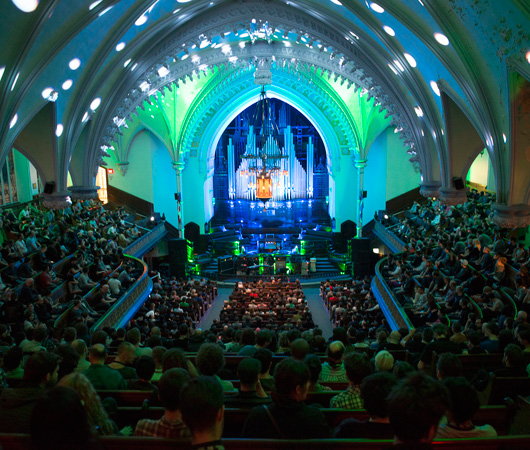
MUTEK 2012 Wrap-Up, Part Two with Tim Hecker, Nicolas Jaar, Kode9, Kink, and More
A lot happened during the first two days of MUTEK 2012—check the wrap-up here—but that […]

A lot happened during the first two days of MUTEK 2012—check the wrap-up here—but that was honestly just a warm-up for the festival’s slate of events over the weekend. With panels, workshops, audio-visual presentations, DJ sets, and live performances scattered around Montreal, there was a lot to see and do, but here’s an accounting of what XLR8R managed to take in.
FRIDAY, JUNE 1
Expérience 3
Place de la Paix
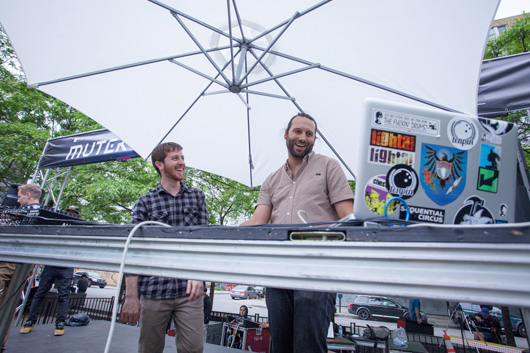
Set in a small park adjacent to the Société des Arts Technologiques (SAT), MUTEK’s Expérience series showcased live sets of electronic music throughout the week, mostly from Canadian producers. Happening in the late afternoon/early evening, the vibe was mellow as people soaked in the beats while sitting on benches and socializing with their friends. Kicking off the third edition of Expérience was Larry James, a collaboration between Vancouver producers Max Ulis and Ryan Trann (a.k.a. Inkwell). Together, the two churned out a groovy brand of house that nicely warmed up the proceedings, even as the weather became a bit chilly. Keeping the bpms low, Larry James’ music could be compared to the output of labels like Crosstown Rebels and Hot Creations, but there was much less camp at work. Time will tell exactly where the project goes, but for now, it sounds rather mature—in a good way.
Nocturne 2
Métropolis/Société des Arts Technologiques (SAT)
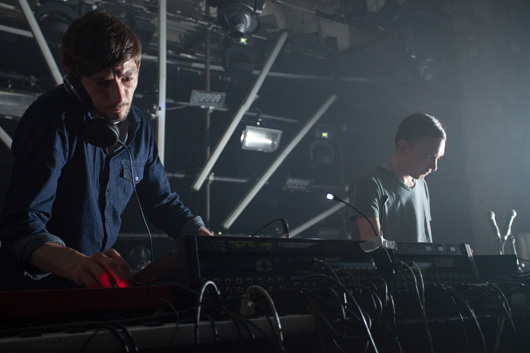
Once again, MUTEK’s nighttime showcases were split between two venues, which required some difficult choices and plenty of shuffling between the two shows. Our night began at the SAT, where Sendai—an experimental collaboration between Belgian techno producers Yves De Mey and Peter Van Hoesen—was presenting the North American debut of its Geotope live A/V show. While traces of techno did punctuate the set, the music was more of an exercise in harsh, ominous sound design, with static, distortion, and an array of non-musical sounds filling the room.
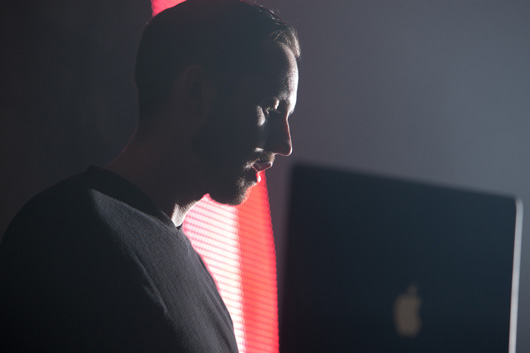
Things changed pretty dramatically once Nautliuss (a.k.a. Graham Douglas Bertie) took the stage. The Toronto-based artist has undergone quite the transformation in recent years, and his most recent incarnation finds him exploring dark, industrial techno. Interestingly though, his live set at MUTEK was quite varied, with essentially three different styles presented over the course of an hour. After beginning with some ambient, beatless tunes that showcased wandering synth melodies and spacey effects, he quickly segued into more dancefloor fare, offering churning techno beats that hinted at ’90s tropes. Toward the end of the set, he again changed directions pretty radically, bringing out a vocalist and dumping the techno in favor of anthemic electronic pop. Although the dancefloor naturally came to a stop, the music was well received and Nautiluss left the stage to a warm ovation from the crowd.
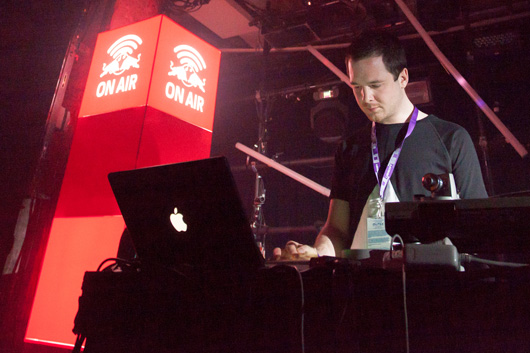
Up next was another live set, this time from UK producer BNJMN, who was actually making his North American debut. While his recorded output is often somewhat dark and shadowy, here it was rather bright, as he unfurled multiple layers of washy synths over a steady techno pulse. Granted, the tone was a bit melancholy, but the melodic flair was unexpected and enjoyable. Unfortunately though, BNJMN was a victim of scheduling, as Nicolas Jaar was scheduled to take the stage over at Métropolis, which prompted a slow exodus from the venue. Caught up in that current, we crept out the door and headed a few blocks away to see what Jaar was up to.
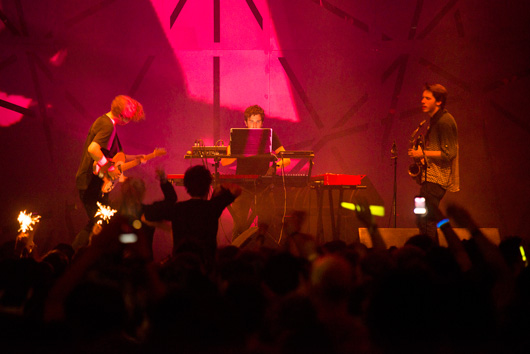
Entering Métropolis, it was immediately apparent that the cavernous venue was more full than it had been the entire week. Nicolas Jaar was already on stage and in full swing, flanked by a guitar player on his right and a saxophone player on his left. The opening minutes of the set were loose and improvisational, though Jaar quickly riled up the crowd once he began to periodically unleash a thunderous house kick. Yet the set never became a full-blown party, as Jaar would oscillate between pounding four on the floor and more mellow, glitch-infused interludes. The vocals were largely kept to a minimum, giving the music a sort of anthemic, instrumental rock feel. That said, there always remained a palpable sense of groove and the crowd was enthusiastic, to say the least.
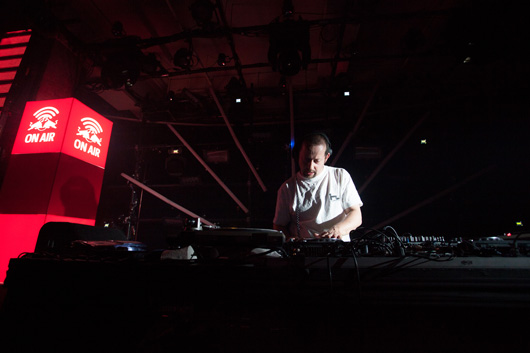
After taking in most of Nicolas Jaar’s set, we hopped back to the SAT with the intention of checking out Hyperdub bossman Kode9. As we moved toward the dancefloor, he was already perched behind the decks, spinning what sounded like ’90s rave cuts before abruptly moving into hyperactive, drum-heavy grime. Over the next hour and a half, he touched on house, garage, grime, funky, bassline, drum & bass and seemingly every niche of low-end heavy UK sounds, not to mention bits of hip-hop, R&B, and juke. While that might sound like some kind of fractured mess, Kode9 was quite adept in hopping from one genre to the next without losing momentum. Even better, he wasn’t simply playing the big tunes from each corner of the electronic spectrum. Instead, he preferred to continually walk the edge and focus on each genre’s oddballs, somehow stringing them all together without losing the dancefloor. All in all, it was a remarkably fun set, and one that showcased how much Kode9 has changed as a DJ. He was playful, did plenty of rewinds, and refused to shy away to big bass and ravey synths. While the initial plan was to check out a chunk of his set and then head back to Métropolis for Jimmy Edgar, Kode9 was simply too good, prompting most in attendance to stay until the lights came on and security began to usher everyone out the door.
SATURDAY, JUNE 2
Expérience 3
Société des Arts Technologiques (SAT)
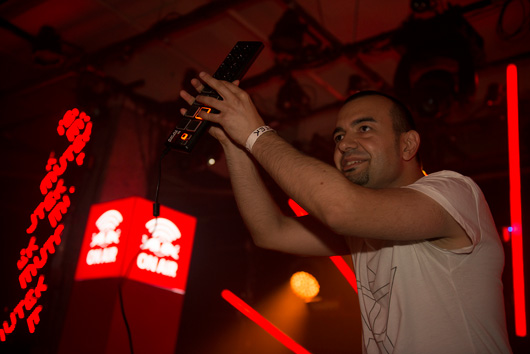
Unfortunately, Saturday was greeted with the worst weather Montreal had seen all week, with a steady rain falling throughout the day. As a result, the afternoon’s Expérience session, originally scheduled to take place outside at Place de la Paix, was moved indoors at the SAT. Despite the change in venue, Bulgaria’s Kink wasn’t deterred from delivering one of the festival’s standout performances. Performing live, happily bopping to the music on stage, and utilizing an array of neon-lit controllers—including an unusual, light saber-reminiscent device that may have been a virtual theremin—he delivered a bouncy, energetic set of pumping house and techno. Kink isn’t shy about jacking classic ’90s riffs and reappropriating them, and did so frequently, to the delight of those in attendance. Dropping plenty of piano house and big-room basslines, Kink’s set wasn’t exactly groundbreaking, but it was a hell of a lot of fun. Plus, he added some extra flair to the proceedings by playing many of the melodies himself—this wasn’t the average low-energy Ableton affair. When the set wrapped up 90 minutes later, he left the stage to one of the week’s warmest ovations.
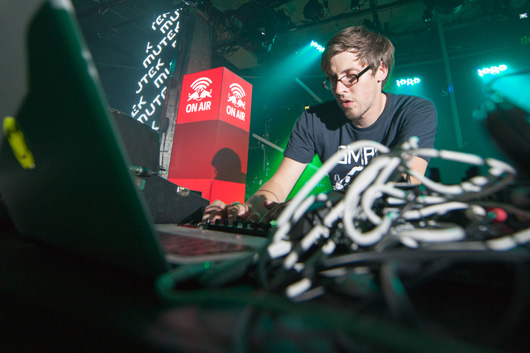
Perhaps the only person who didn’t appreciate Kink’s set was the afternoon’s final performer, Jacob Korn. This is complete conjecture of course, but the speculation is based on the fact that Korn’s harder, more linear brand of house and techno simply couldn’t match the dynamism delivered by Kink. Despite riding a certain amount of hype that’s been bubbling throughout 2012, Korn’s mature offerings, while quality, sapped the room of its energy and prompted many MUTEK patrons, most of whom still had long nights ahead, to shuffle towards the door.
A/Visions 4
Église Unie St. James
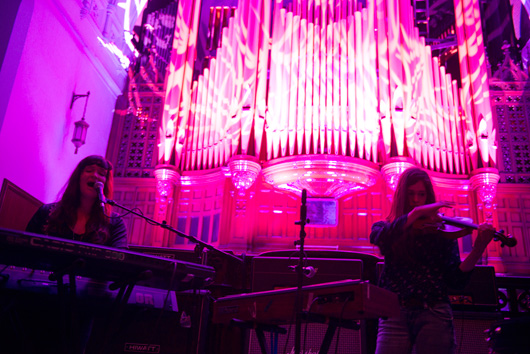
While the A/Visions series had been happening throughout the week, usually featuring electronic artists playing special audio-visual sets, the festival’s final A/Visions session of 2012 was the first one we managed to attend, and it was flat-out amazing. Set in a breathtaking church in downtown Montreal, the night began with a performance from Les Momies de Palerme.The local duo, featuring mutli-instrumentalists Xarah Dion and Marie Davidson, offered engaging and dramatically ethereal songs that were essentially free of percussion. Combining droning synths and thoughtful violin melodies with their own angelic voices, the music recalled a variety of seminal soundtracks, ultimately coming off like a cross between Blade Runner and Deadwood, with some vaguely Eastern elements thrown in for good measure. The set did become slightly more experimental as time wore on, veering toward avant-pop. These tunes were not bad, but they also didn’t quite stand up to the grandiose efforts which colored the first portion of the girls’ set.
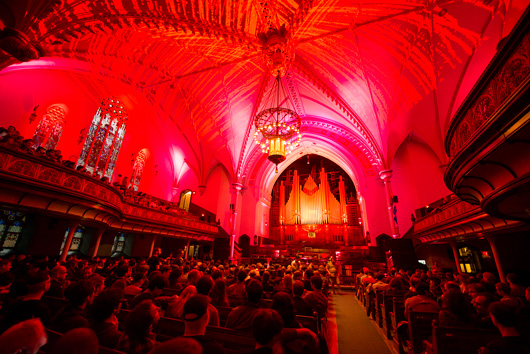
It’s likely that Les Momies de Palerme was a pleasant surprise for much of the crowd, as almost everyone in attendance—and, make no mistake, the church was stuffed to the rafters—was there to see Tim Hecker, who was performing in collaboration with guitarist Stephen O’Malley of Sunn O))). While O’Malley set up in front of an impressive array of very large amps, Hecker sat in the background, manipulating bits of static and noise, not to mention the church’s massive organ. From the opening notes of the duo’s set, it was clear that this show was going to be loud—very loud. Acting like a sort of sonic tide, waves of noise, distortion, and reverb washed over the audience again and again. Occasionally morphing into a churning, growling mass and moving with the deliberateness of a glacier, the music was foreboding, intense, and carried a sense of majestic doom. Calling it a soundtrack to the end of the world may seem a bit trite, but there was something truly apocalyptic about the sounds these two were creating, which definitely conjured memories of films like War of the Worlds and Close Encounters of the Third Kind. The main difference here was that at the end of the proceedings, everyone was still alive. More importantly, they left happy, even if Hecker and O’Malley had rumbled their guts a bit.
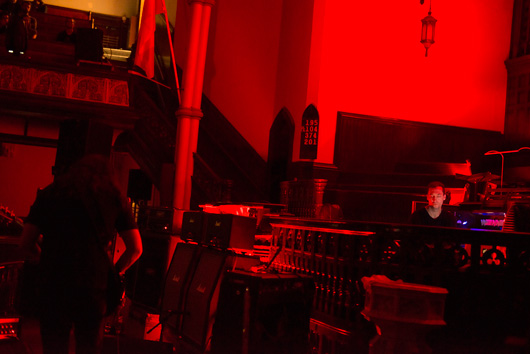
Nocturne 4
Métropolis/Société des Arts Technologiques (SAT)
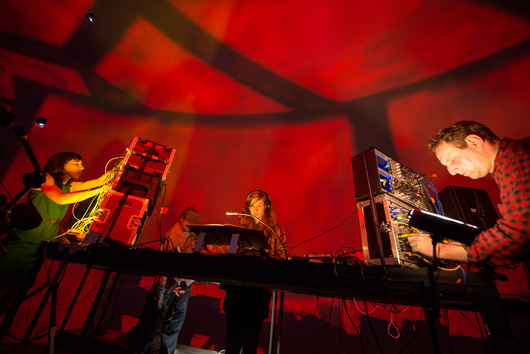
After leaving the A/Visions performance, many patrons trudged across downtown Montreal in the rain and sought shelter in the SAT, where a special showcase had been assembled in a different portion of the venue than the rest of the week’s performances. Located on the third floor and known as the Satosphere, the space is a vaulted dome with immersive, 360-degree projections. More than anything, just standing inside the dome and feeling enveloped by the visuals was a satisfying enough experience. The music presented was largely a bonus, and the first blast came courtesy of Jeremy Greenspan, better known as one half of Junior Boys. Performing in tandem with Christina Sealy and Jessica Lanza, Greenspan offered a unique take on Bach classics, which the trio simultaneously ran through two separate modular synthesizers.
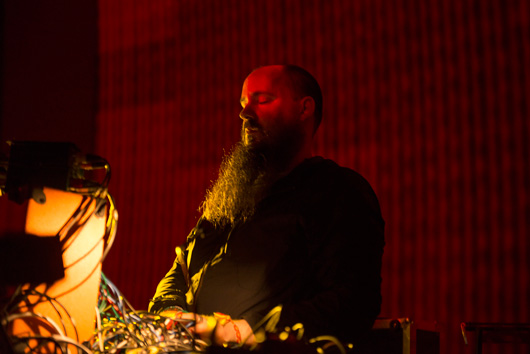
The next performance came from electronic prodigy Keith Fullerton Whitman. Also operating on a modular synth, Whitman tapped out a session of glitchy experimentalism while those in attendance continued to crane their necks and be overwhelmed by the impressively towering visuals in the dome. Seeking a different sort of spectacle, we left the SAT and headed to Métropolis in search of some dancefloor fare.
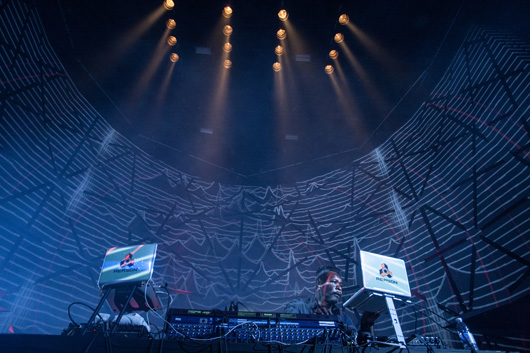
Walking into Métropolis, it was immediately apparent that A Guy Called Gerald had the dancefloor kicking, initially with an assault of churning, acid-tinged techno. Performing live, he eventually segued into some stripped-down jungle, serving up rolling rhythms, thunderous drums, and essentially no melody. It was very tribal, very raw, and the crowd ate it up, particularly when Gerald came out from behind the decks and dusted off some of his old dance moves. At some point, he did make the dubious claim that he had invented a new genre, which he dubbed “stepno.” It essentially sounded like drum & bass with some wobbly dubstep basslines, so the party didn’t suffer. Eventually, Gerald slowed things down and moved back into techno, delivering warehouse vibes and pounding analog beats with rubbery basslines and raw drum sounds. Only at the end of the set did things truly cool down, as Gerald reeled in the energy with soft pads and some headier selections before wrapping things up.
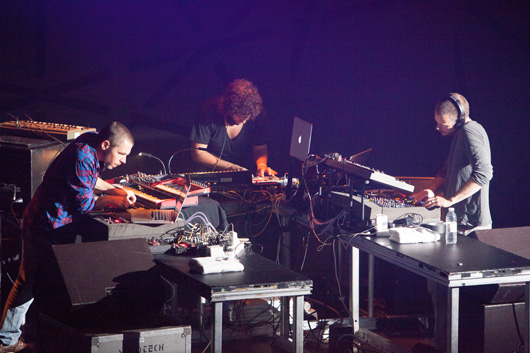
Things went deeper with the next performance, a special collaboration between Swedish duo Minilogue and Canada’s Mathew Johnson. All three men huddled together on stage, assembling a steady techno rhythm colored by washy underwater synths. Over time, the trio gradually weaved in ravier melodies and stepped up the kick, which drew cries of approval from the dancefloor. Overall though, the vibe was somewhat hypnotic, as the music conveyed the sense of taking a journey. However, as the set crept into its second hour, the need to sleep came to the forefront and we journeyed back to our hotel to rest up for one last day of MUTEK.
SUNDAY, JUNE 3
Piknic
Parc Jean-Drapeau
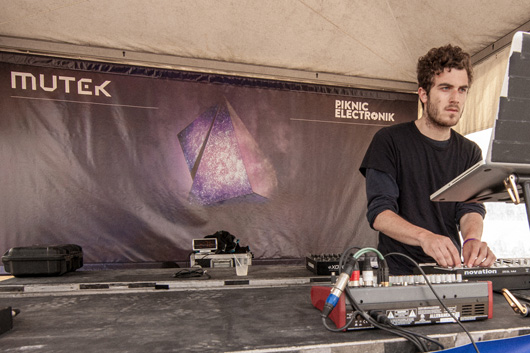
While the constant downpour of Saturday had the entire festival fretting about the status of MUTEK’s annual Piknic, the weather thankfully cooperated and allowed things to move ahead as planned. (Interestingly enough, the island of Montreal was actually surrounded by two separate weather systems the entire day. As such, stormy weather and rainfall literally circled the city, but somehow, Piknic was left unscathed.) Upon our arrival, the afternoon’s secret guest, Nicolas Jaar, was already in the midst of an impromptu DJ set. Although he was using Ableton with a controller and not actually DJing in the traditional sense, his selections were certainly appropriate for a laid-back afternoon in the park. Beginning with a number of mellow grooves, he slowly inched the tempo upward, playing almost exclusively his own edits of hip-hop, R&B, funk, disco, and more. Smartly, Jaar never went full throttle, instead utilizing songs with lots of organic sounds and real instruments to warm up the afternoon.
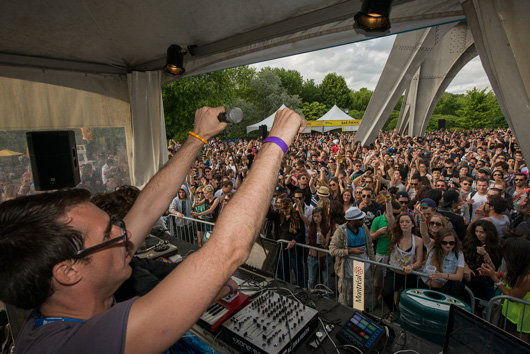
Some of that restraint could have been used by the other performers on Piknic’s main stage, beginning with Benoit & Sergio. Granted, the duo’s anthemic party vibes were greedily gobbled up by the crowd, which had significantly swelled in size. Nevertheless, it’s hard to look past how much the pair hammed it up on stage, particularly with the vocals. Admittedly, this sort of carefree, “fuck it, let’s have a good time” attitude is a big part of Benoit & Sergio’s appeal, but it did seem a tad out of place at MUTEK.
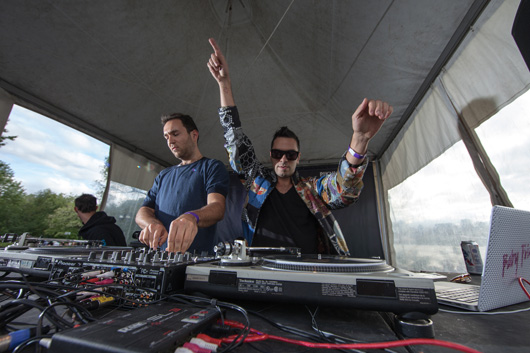
That said, Benoit & Sergio were light years more tolerable than Wolf + Lamb, who shamelessly preened and posed for the crowd while offering one easily digestible track after another. Gadi Mizrahi was particularly objectionable with his hands-in-the-air posturing and insistence on playing air piano over his records. Musically, the pair played a combination of Crosstown Rebels-style house, vintage R&B, and disco, none of which was awful. Nevertheless, it felt dumb, which is why we smartly made a beeline for the Piknic’s second stage.
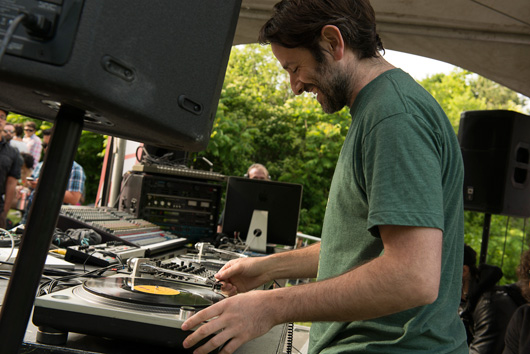
Closing out the afternoon in the second stage’s cozy confines was none other than The Mole, who pretty much stole the show that afternoon. Playing mostly groove-heavy techno while occasionally veering into house, disco, and funk, he demonstrated how to play a fun, dancefloor-friendly set while still keeping the music mature. It was a stark contrast to all the silliness happening over at the main stage, which is why a dedicated crew stayed put and took in his lengthy set as the sun went down.
Nocturne 5
Société des Arts Technologiques (SAT)
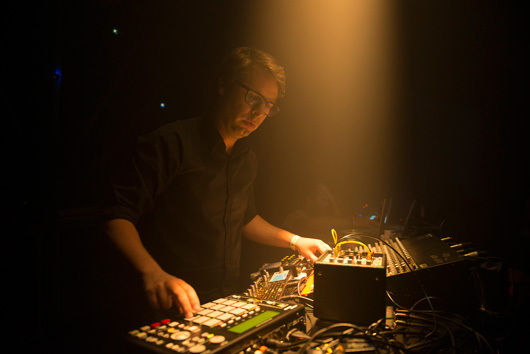
MUTEK’s final night offered a diverse lineup and one last chance to congregate at the SAT. When we arrived, Germany’s Farben (a.k.a. Jan Jelinek) was playing a live set of polite, measured, and almost mathematical techno. Changes were small and gradual, as the energy level slowly climbed but never boiled over, even at its peak. There was a dreamy quality to the music, as its fuzzy pads and lightly bubbling flourishes slowly drew in the crowd. In fairness, this kind of pensive, thoughtful techno might be better suited for headphones than the club, but early in the evening, it provided a comfortable warm up.
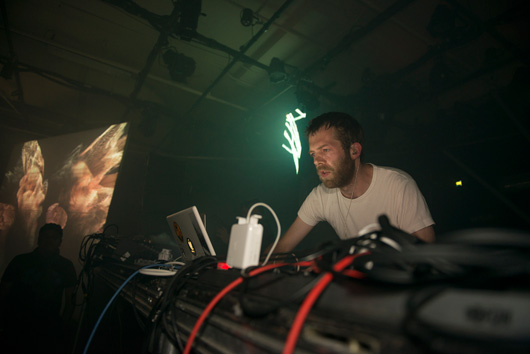
The mood shifted considerably once Alex Smoke took the stage. Debuting the A/V live show of his new Wraetlic project, he offered an array of harsh, glitchy beats and ominously pitched-down vocals. There was a sort of witch-house vibe to the music, although the project appeared to be much more rooted in ’90s IDM than youthful goth experimentalism. The lurching percussion was heavy on sharp clicks and clacks, and aside from a few interludes of storming, industrial-tinged techno, the rhythms were rarely of the four-on-the-floor variety. Smoke’s voice was often the centerpiece element, appearing on nearly every tune, albeit in a form that was warped and twisted to the point where it was barely recognizable as human.
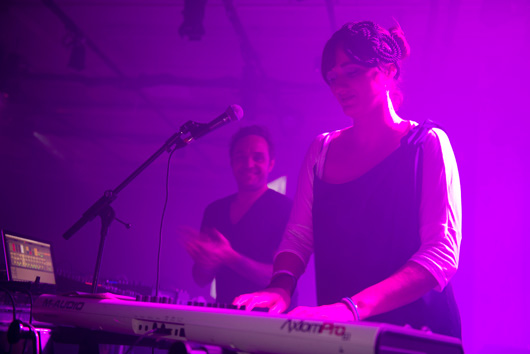
After an hour of (admittedly well constructed) gloom, the live set from Public Lover cheered up the room in a hurry. A collaborative project between Bruno Pronsato and his girlfriend, French singer-songwriter Nina Leece, Public Lover took the stage and played a bouncy brand of funk-tinged techno, one with plenty of disco bounce. Smoothly produced without sounding overly slick, the music charmed the audience, thanks in large part to Leece’s sweet, slightly deadpan singing. Filled with big piano chords, the set was upbeat and positive, the kind of music that makes people feel like the party should never end. In short, the crowd loved it, and just about everyone was dancing with a big smile on their face.
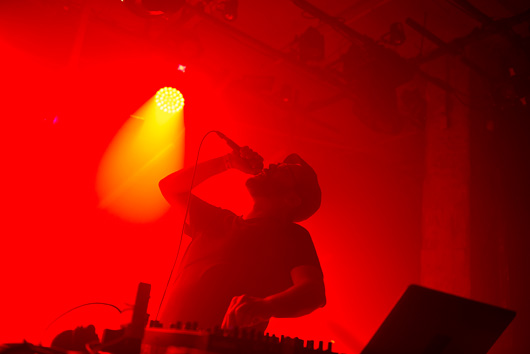
The festival’s final performance came courtesy of San Francisco producer Dave Aju, who debuted a brand-new live set. Beginning with breakbeats and a talk-sung intro, Aju gradually unfurled swirling synths and funk basslines. At one point covering Donna Summer’s “I Feel Love” and singing live over most of the set, Aju at times ventured too far into cheese territory, but also came across something like a more psychedelic Jamie Lidell. He’d be better served by cutting down on the vocals, especially on the tunes with slam-poetry-esque lyrics, but the music went down fairly easily and wrapped MUTEK on a positive note.
And so concluded another edition of MUTEK. As always, the festival had some great performances, while others were less than optimal. That said, MUTEK isn’t something that can be accurately assessed on an artist-by-artist or show-by-show basis. It’s bigger than that, and on the whole, there’s little question that MUTEK continues to be one of the world’s most adventurous and impeccably curated festivals. Concretely devoted to boundary-pushing art, the embrace of technology, and underground electronic music, its continued existence is cause enough for celebration, which is why XLR8R was once again happy to take part.

